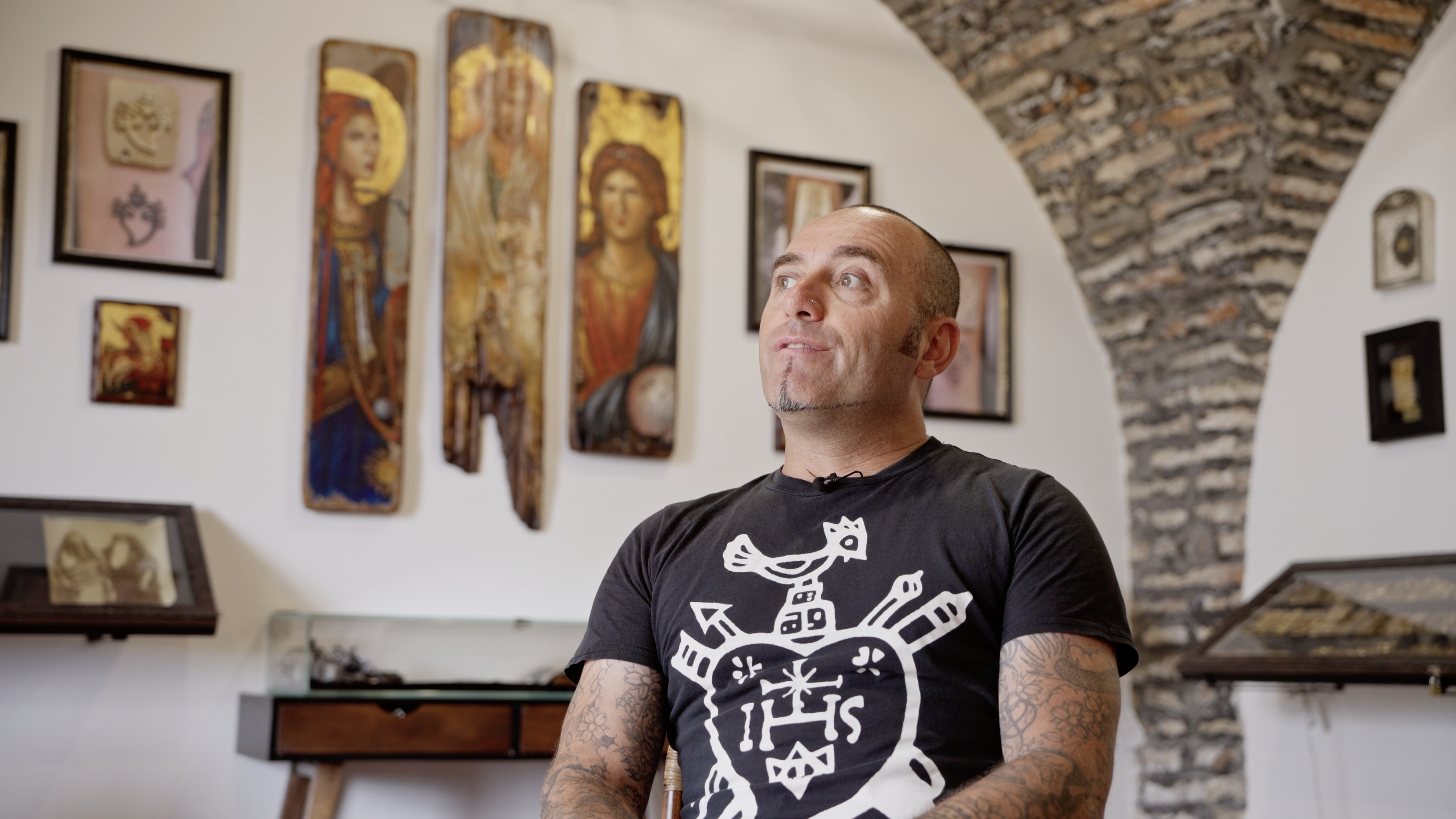The (Religious) Craft of Tattooing
DOI:
https://doi.org/10.29340/en.v8n15.396Keywords:
tattoo, religious icons, lived religion, CatholicismAbstract
Religious tattooing has evolved from a ritual to a profession. By materializing beliefs, tattooists experience the tension between art and spirituality. This study examines how tattoo parlors have become a space where contemporary religious expression is configured, exploring the intersections between art, spirituality, and trade.
Downloads
References
Alker, Zoe y Robert Shoemaker (2022). “Convicts and the Cultural Significance of Tattooing in Nineteenth-Century Britain”, Journal of British Studies 61, pp. 835-862.
Ameigeiras, Aldo (1989). “El fenómeno de la religiosidad popular desde la perspectiva de la Ciencia Social”, Revista cias 386, pp. 403-412.
Ammerman, Nancy T. (2021). Studying Lived Religion. Nueva York: New York University Press.
Atkinson, Michael (2003). Tattooed: The Sociogenesis of a Body Art. Toronto: University of Toronto Press.
Back, Les (2007). The Art of Listening. Oxford y Nueva York: Berg.
Barber, Charles (1999). “Writing on the Body: Memory/Desire and the Holy in Iconoclasm”, en Desire and Denial in Byzantium: Papers from the 31st Spring Symposium of Byzantine Studies, University of Sussex, 111-120. Brookfield, VT: Aldershot.
Barras, Amelie y Anne Saris (2021). “Gazing into the World of Tattoos: An Invitation to Reconsider How We Conceptualize Religious Practices”, Studies in Religion, 50, 2, pp. 167-188.
Bell, Shannon (1999). “Tattooed: A Participant Observer’s Exploration of Meaning”, Journal of American Culture, 22, 2, pp. 53-58.
Bender, Courtney, Wendy Cadge, Peggy Levitt y David Smilde (2013). Religion on the Edge: De-centering and Re-centering the Sociology of Religion. Nueva York: Oxford University Press.
Benson, Susan (2000). “Inscriptions of the Self: Reflections on Tattooing and Piercing in Contemporary Euro-American”, en Jane Caplan (ed.). Writen on the Body. The Tattoo in European and American History. Princeton: Princeton University Press, pp. 234-254.
Boudreau, Julie-Anne, Laura Ferro Higuera y Aitiana Villamar Ruelas (2020). “Ser y estar en lo urbano. Un acercamiento espacio-temporal al tatuaje”, Disparidades. Revista de Antropología, 72, 2, pp. 1-15.
Brain, Robert (1979). The Decorated Body. Nueva York: Harper and Row.
Bruna, Denis (2005). “Le ‘Labour dans la Chair’. Témoignages et représenttions du tatouage au moyen age”, en Agostino Paravicini Bagliani (ed.). La pelle umana: The Human Skin. Florencia: Edizioni del
Galluzzo, pp. 389-407.
Cann, Candi K. (2014). Virtual Afterlives: Grieving the Dead in the Twenty-First Century. Lexington: University Press of Kentucky.
Davidson, Deborah (2016). The Tattoo Project: Commemorative Tattoos, Visual Culture, and the Digital Archive. Toronto: Canadian Scholars.
De la Torre, Renée, Cristina Gutiérrez Zúñiga, María Patiño López, Yasodhara Silva Medina, Hugo Suárez y Genaro Zalpa Ramírez (2014). Creer y practicar en México: comparación de tres encuestas sobre religiosidad. Ciudad de México: Universidad Autónoma de Aguascalientes/CIESAS/El Colegio de Jalisco.
De Oliveira, R. (2016). “Tatuadores, tatuados: pesquisa e reflexão estética”, IDE-Sao Paulo, 61, pp. 149-167.
DeMello, Margo (2000). Bodies of Inscription: A Cultural History of the Modern Tattoo Community. Durham y Londres: Duke University Press.
Denzinger, Heinrich (1957). The Sources of Catholic Dogma. St. Louis: Herder.
Dougherty, Kevin y Jerome Koch (2019). “Religious Tattoos at One Christian University”, Visual Studies, 34, 4, pp. 311-318.
Ebensten, Hanns (1954). Pierced Hearts and True Love: An Illustrated History of the Origin and Development of European Tattooing and a Survey of its Present State. Londres: Derek Verschoyle.
Falk, Pasi (1995). “Written in the Flesh”. Body and Society 1, núm. 1: 95-105.
Ferreira, Vítor (2008). “Os ofícios de marcar o corpo: a realização profissional de um projecto identitário”, Sociologia, Problemas e Praticas, 58, pp. 71-108.
Firmin, Michael, Luke Tse, Tammy Angelini y Janna Foster (2012). “A Qualitative Assessment of Internal Factors for Tattooing among CollegeStudents”, College Students Affairs Journal 30, núm. 2, pp. 31-44.
Foemmel, Eric Wayne (2009). “An Ethnographic Case Study of a Los Angeles Tattoo Shop”. Tesis de doctorado. Pennsylvania: The Pennsylvania State University.
Gilbert, Steve (2000). Tattoo History: A Sourcebook. Nueva York: Juno Books.
Govenar, Alan (1988). “The Variable Context of Chicano Tattooing”, en Arnold Rubin (ed.). Marks of Civilization: Artistic Transformations of the Human Body. Los Ángeles: Museum of Cultural History-University of California, pp. 209-217.
Guerzoni, Guido (2018). “Devotional Tattoos in Early Modern Italy”, Espacio, Tiempo y Forma 6, pp. 119-136.
Gustafson, Mark (2000). “The Tattoo in Later Roman Empire and Beyond”, en Jane Caplan (ed.). Written on the Body: The Tattoo in European and American History. Princeton: Princeton University Press, pp. 17-31.
Inckle, Kay (2016). “‘Physical Words’: Scars, Tattoos, and Embodied Mourning”, en Deborah Davidson (ed.). The Tattoo Project. Commemorative Tattoos, Visual Culture, and the Digital Archive. Toronto: Canadian Scholars, pp. 113-124.
Jones, Christopher (2000). “Stigma and Tattoo”, en Jane Caplan (ed.). Written on the Body: The Tattoo in European and American History. Princeton: Princeton University Press, pp. 1-16.
Kloss, Sinah Theres (2022). “Embodying Dependency: Caribbean Godna (tattoos) as Female Subordination and Resistance”. The Journal of Latin American and Caribbean Anthropology, pp. 1-12.
Kluger, Nicolas (2021). “Le tatouage religieux”, Annales de Dermatologie et Vénéréologie, 139, 11, pp. 776-782.
Kosut, Mary (2014). “The Artification of Tattoo: Transformations within a Cultural Field”. Cultural Sociology 8, 2, pp. 142-158.
Krutak, Lars. (2015). “The Cultural Heritage of Tattooing: A Brief History”. Current Problems in Dermatology, 48, pp. 1-5.
Le Breton, David (2013). El tatuaje o la firma del yo. Madrid: Casimiro.
López Fidanza, Juan Martín y Cecilia Galera (2014). “Regulaciones a una devoción estigmatizada: culto a San La Muerte en Buenos Aires”, Debates do NER 15, 25, pp. 71-196.
MacQuarrie, Charles W. (2000). “Insular Celtic Tattooing: History, Myth, and Metaphor”, en Jane Caplan (ed.). Written on the Body: The Tattoo in European and American History. Princeton: Princeton University Press, pp. 32-45.
Maldonado-Estrada, Alyssa (2020). Lifeblood of the Parish: Men and Catholic Devotion in Williamsburg, Brooklyn. Nueva York: New York University Press.
Maloney, Patricia y Jerome Koch (2019). “The College Student’s Religious Tattoo: Respect, Reverence, Remembrance”, Sociological Focus 53, 1, pp. 53-66.
Martin, Chris William (2018). The Social Semiotics of Tattoos: Skin and Self. Bloomsbury Publishing.
Morello, Gustavo y Tiago De Paula (2024). “Tattoo Artists as Religious Figures”, Journal for the Scientific Study of Religion, 00, 0, pp. 1-20, https://onlinelibrary.wiley.com/doi/10.1111/jssr.12910
Morello, Gustavo, Mikayla Sanchez, Diego Moreno, Jack Engelmann y Alexis Evangel (2021). “Women, Tattoos, and Religion: An Exploration into Women’s Inner Life”, Religions, 12, 7, pp. 517-531.
— (2021). Lived Religion in Latin America: An Enchanted Modernity. Nueva York: Oxford University Press.
— (2021a). I’ve Got You Under my Skin: Tattoos and Religion in Three Latin American Cities, Social Compass, 68, 1, pp. 61-80.
— (2024) Alma, corazón y tinta. Los tatuajes en el cristianismo. Córdoba: Clarice Ensayos/Nelson Specchia Editor.
Parker Gumuccio, Cristian (1998). “Modern Popular Religion. A Complex Object of Study for Sociology”, International Sociology 13, 2, pp. 195-212.
Parnell, Julia (2019). “Stigmata: An Ethnographically Informed Approach to the Religious Tattoo in America”, Claremont Graduate University, ProQuest 13862075.
Pereira Arenas, Valentina y Gustavo Morello (2022). “Entre el opio del pueblo y la búsqueda de la salvación. Aproximaciones a la ‘religiosidad vivida’ desde América Latina”, Revista de Estudios Sociales, 82, octubre-diciembre, pp. 3-21.
Pérez Fonseca, Andrea (2009). “Cuerpos tatuados, ‘almas’ tatuadas: nuevas formas de subjetividad en la contemporaneidad”, Revista Colombiana de Antropología 45, 1, pp. 69-94.
Petkoff, Peter (2019). “Christian Tattoos as a Normative Demarcation of Memory, Defiance and Eternal Return”, en Miriam Diez Bosch, Alberto Melloni y Josep Mico Sanz (eds.). Perplexed Religion. Barcelona: Blanquerna Observatory, pp. 57-72.
Pitts, Victoria (2003). In the Flesh: The Cultural Politics of Body Modification. Nueva York: Palgrave and Macmillan.
Price, Richard (2018). The Acts of the Second Council of Nicaea (787): Translated with Notes and an Introduction. Liverpool: Liverpool University Press.
Rabbia, Hugo, Gustavo Morello, Néstor Da Costa y Catalina Romero (2019). La religión como experiencia cotidiana: creencias, prácticas y narrativas espirituales en Sudamérica. Córdoba: Educc.
Ramos, Beatriz Eugenia (2002). “La letra con sangre entra: disquisiciones acerca del tatuaje”, Desde el Jardín de Freud, 2, pp. 62-67.
Rees, Michael (2016). “From Outsider to Established. Explaining the Current Popularity and Acceptability of Tattooing”, Historical Social Research, 41, 3, pp. 157-174.
Resenhoeft, Annette, Julie Villa y David Wiseman (2008, mar-abr). “Tattoos Can Harm Perceptions: a Study and Suggestions”, J Am Coll Health, 56 (5), pp. 593-596.
Rivardo, Mark y Colleen Keelan (2010). “Body Modifications, Sexual Activity, and Religious Practices”, Psychological Reports, 106, núm. 2, 467-474.
Rosenblatt, Daniel (1997). “The Antisocial Skin: Structure, Resistance and ‘Modern Primitive’ Adornment in the United States”, Cultural Anthropology, 12, 3, pp. 287-334.
Rubin, Arnold (1988). “General Introduction”, en Arnold Rubin (ed.). Marks of Civilization: Artistic Transformations of the Human Body. Los Ángeles: Museum of Cultural History and University of California, pp. 13-17.
Sanders, Clinton y Angus Vail (2008). Customizing the Body. The Art and Culture of Tattooing. Philadelphia: Temple University Press.
Scheinfeld, Noah (2007). “Tattoos and Religion”, Clinics in Dermatology, 25, pp. 362-366.
Schildkrout, Enid (2004). “Inscribing the Body”, Annual Review of Anthropology, 33, pp. 319-344.
Seman, Pablo (2021). Vivir la fe. Entre el catolicismo y el pentecostalismo, la religiosidad de los sectores populares en la Argentina. Buenos Aires: Siglo xxi.
Sizer, Laura (2020). “The Art of Tattoos”. The British Journal o Aesthetics, 60, 4, pp. 419-433.
Steward, Samuel (1990). Bad Boys and Tough Tattoos: A Social History of the Tattoo with Gangs, Sailors and Street-Corner Punks 1950-1965. Nueva York: Harrington Park Press.
Tranter, Bruce y Ruby Grant (2018). “A Class Act? Social Background and Body Modifications in Australia”, Journal of Sociology, 54, 3, pp. 412-428.
Tsou-Pin Chen, Molly (2019). “A Phenomenological Study on the Lived Experience of Tattoo Artists”. Tesis de doctorado. Chicago: The Chicago School of Professional Psychology, proQuest 13805815.
Walzer-Moskovic, Alejandra (2015). “El arte en el discurso de los tatuadores”, Arte, Individuo y Sociedad, 27, 3, pp. 463-481.
Wolff, Kurt (1950). The Sociology of Georg Simmel. Traducido, editado y con introducción de Kurt H. Wolff. Glencoe: The Free Press.
Woodstock, Louise (2014). “Tattoo Therapy: Storying the Self on Reality tv in Neoliberal Times”. The Journal of Popular Culture, 47, 4, pp. 780-799.
Yllescas, Adrián. 2018. “Los altares del cuerpo como resistencia ante el poder carcelario”, Encartes, 1, (1), pp. 121-139.

Downloads
Published
Issue
Section
License
Copyright (c) 2025 Encartes

This work is licensed under a Creative Commons Attribution-NonCommercial 4.0 International License.
Aviso de derechos de autor
- Los autores/as conservan los derechos de autor y ceden a la revista el derecho a la primera publicación con el trabajo registrado con la licencia de atribución Creative Commons, que permite a terceros utilizar lo publicado siempre que mencionen la autoría del trabajo y a la primera publicación en esta revista
- Los autores/as pueden realizar otros acuerdos contractuales independientes y adicionales para la distribución no exclusiva de la versión del artículo publicado en esta revista (por ej. Incluirlo en un repositorio institucional o publicarlo en un libro) siempre que indiquen claramente que el trabajo se publicó por primera vez en esta revista.
El material puede ser copiado, distribuido, comunicado, ejecutado públicamente. Se pueden hacer obras derivadas de él. No se puede utilizar para fines comerciales. Se debe reconocer y citar la obra de la forma en que tú especifiques.









